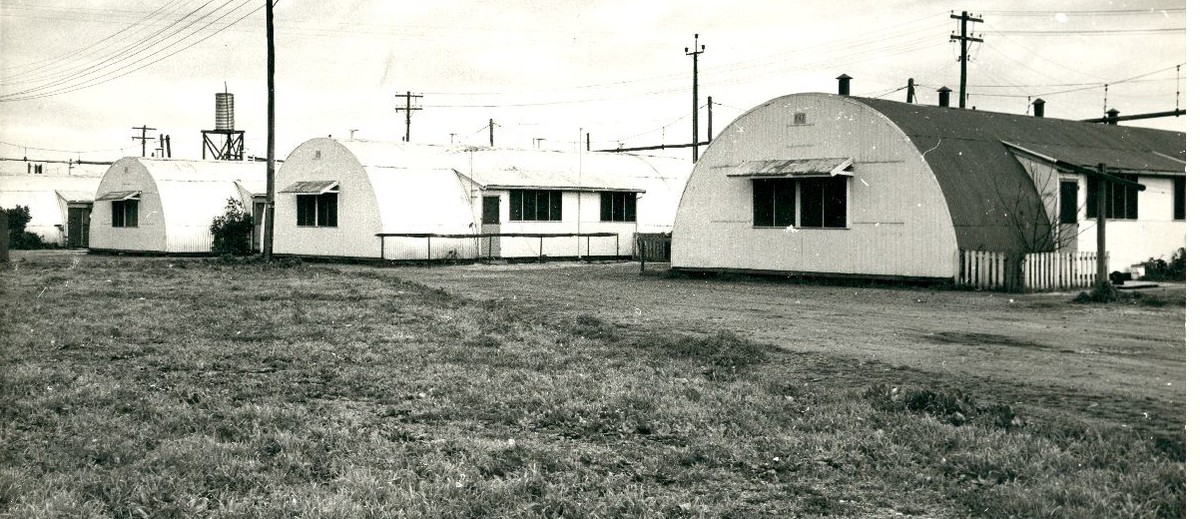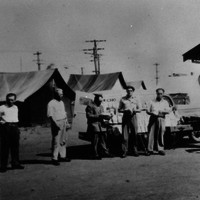Tens of thousands of people went through work camps and migrant hostels in South Australia. Migrant hostels were also known as migrant camps, reception centres and holding centres. There were at least twelve hostels in South Australia between 1947 and the mid-1980s.
Migrant Hostels
Hostels were funded and run by Commonwealth and State Governments. The first migrant hostels were built in the midst of an acute housing shortage. They were established in existing buildings, often military barracks with communal dining, laundry and shower facilities. Later, transportable structures like Nissen huts were used. Hostels assisted new arrivals to settle in and establish themselves before striking out on their own.
The South Australian Story
In addition to the government-run hostels listed below there were a number of camps or work hostels run directly by organisations that employed large numbers of migrants. These included sites at Salisbury and Hendon, and those run by the South Australian Railways in Adelaide (North Terrace), Islington and Peterborough, the Engineering and Water Supply Department in Bedford Park and Leigh Creek, and the Woods and Forests Department in Mount Gambier, among others.
Research is ongoing, and definite numbers and locations of work camps are not yet known. Some appear to have operated along very similar lines to the sites that have been referred to here as migrant hostels. Many were even more transitory, or temporary, in nature, taking the form of tent cities, or utilising whatever buildings were available.
The following migrant hostels are known to have operated in South Australia under government administration as indicated:
Commonwealth
Woodside, 1949 - 1963
Smithfield, 1949 – 1971
Mallala, 1950 – 1951
Rosewater, 1950 - 1953
Willaston (Gawler), 1949 – 1952 & 1955 – 1956
Glenelg, 1949 – 1971
Finsbury, 1950 – 1966, renamed Pennington 1966 – c. 1990s
State
Elder Park, November 1947-1969
Semaphore, 1949-1957
Woodville, c. 1969 – c.1978
Shared or split control
Gepps Cross, 1951 – 1952 (Commonwealth) 1952 – c. 1965 (State)
Milpara (Whyalla), 1949 – c. 1977 (funding split between Commonwealth, State & BHP)
Interstate

Thanks for posting Wilhelmina,
If you do find a photo you can share here by clicking the 'add to' plus sign up at the top right of the article.
Probably we were there around same time or maybe a year earlier. Our pictures are everywhere but might find one. If so, will post.

I lived in Glenelg in the 50s 60s and attended St Leonard’s Primary Schools. The vast majority of the students and there were many, were Dutch. I loved them. The camps were situated juxtaposed the airport!!! Can you imagine the noise and to top it off the Pattawalonga was just a stone’s throw away with all its horrific stenches. These must have been most difficult times but they shone. I remember them with love and kindness. Thanks to all the Jans and the chocolate spread

Hi Sean,
here we've focused on sites run by Commonwealth or State governments as migrant hostels or reception centres, there were many more run by individual government departments and other organisations. Research is continuing at the University of Adelaide, and Dr Karen Agutter has put together a 'find your family' guide which outlines where you can find further records on the hostels and people who stayed there - https://arts.adelaide.edu.au/humanities/hostel-stories/
My parents immigrated to Adelaide Australia from the UK with my brother and I around November 1971. I recall staying in an immigration camp in the Clovercrest/Para Hills area for a few months, but this camp doesn’t seem to be recognized. Was there an immigration camp in Colver rest/Para Hills?

Thanks Hans
Quite a few families moved from Woodside to Glenleg as the government improved things. You can find articles on the individual hostels in the links to the right of the article above.
We stayed in Glenelg Hostel a few months in 1961. I rember it quite well, I think. We came from Woodside Hostel. I have several photo's (b/w), and I hope to receive some more photo's.

Thanks for sharing Barbara,
If you look at the list of 'related places' to the right of the article above you can see a link to a page about Glenelg and one about Woodside. If you click on the 'media' button on these pages you will be able to see photos of the sites. There are more photos on the Flick group Migrant Hostels which is listed in the 'Links' section under this article.
We stayed in the Glenelg hostel in 1957 after having spent three months at Woodside camp. Shame there are no photos on this site.
Thanks Barb
Agutter, Dr Karen, research notes, Hostel Stories project, the University of Adelaide
Migration Museum, Hostel Stories: Migrant Lives, Work Camps and Interstate Hostels information sheet.
Migration Museum, research files, Work Camps and Interstate Hostels, Hostel Stories
State Library of South Australia, OH 948, Hostel Stories Oral History Project, JD Somerville Oral History Collection, 2010 - 2017




Add your comment